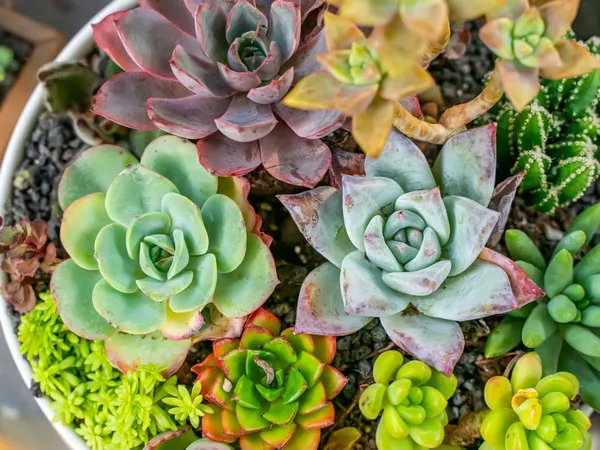Vertical succulent gardens have gained immense popularity as a striking and space-efficient way to display these captivating plants. However, their unique structure and orientation necessitate specific care strategies, particularly when it comes to watering. Successfully maintaining a vertical succulent garden requires an understanding of their water requirements, proper watering techniques, potential challenges, and related considerations. In this article, we will delve into these aspects to provide comprehensive guidance for nurturing your vertical succulent masterpiece.
Understanding Water Requirements of Vertical Succulent Gardens
Before delving into watering techniques, it’s crucial to comprehend the water requirements of succulents. Succulents are known for their ability to store water in their leaves, stems, or roots, enabling them to survive in arid conditions. However, this does not mean they can thrive without proper watering. Understanding the balance between their water storage capacity and hydration needs is key.
1. Selecting the Right Succulents for Your Vertical Garden
Not all succulents are equally suited for vertical gardens. Opt for varieties that naturally stay more compact, have shallow root systems, and exhibit drought tolerance. Examples include Sedums, Echeverias, and Crassulas. Their characteristics will make them more adaptable to the limited soil and water retention capabilities of vertical installations.
2. Assessing Environmental Factors
Consider the specific environmental conditions of your vertical garden’s location. Factors such as sunlight exposure, humidity levels, and wind can impact how often your succulents need water. More sunlight and wind can lead to faster evaporation, necessitating more frequent watering.
Watering Techniques for Vertical Succulent Gardens
Proper watering techniques are crucial to prevent overwatering or underwatering, both of which can be detrimental to succulents. Follow these guidelines to ensure optimal watering for your vertical succulent garden.
1. The “Soak and Dry” Method
This widely recommended method involves thoroughly soaking the soil and allowing it to dry out completely before the next watering. This approach mimics the natural rainfall patterns in succulents’ native habitats. Use your finger to test the soil moisture before watering again.
2. Watering Frequency
Vertical gardens tend to dry out more quickly than traditional horizontal plantings due to their vertical orientation and exposure to sunlight. As a general rule, water your vertical succulent garden more frequently than ground-level gardens. Aim for watering every 1-2 weeks, but adjust based on factors like weather conditions and humidity levels.
3. Watering Time
Early morning is the ideal time to water succulents. Watering during the cooler part of the day minimizes water loss due to evaporation. Avoid watering during the hottest hours, as this can lead to scorching of the leaves.
4. Applying Water Directly to the Soil
When watering your vertical succulent garden, target the soil rather than the foliage. This prevents excess moisture on the leaves, which can lead to rot and fungal issues. Use a watering can with a narrow spout to deliver water directly to the root zone.
5. Ensuring Proper Drainage
Good drainage is essential for succulents, preventing waterlogged soil that can lead to root rot. Use well-draining soil mixes and ensure that your vertical garden has proper drainage holes to allow excess water to escape.
Challenges and Solutions
Vertical succulent gardens present unique challenges related to watering. Addressing these challenges will help you maintain a thriving garden.
1. Uneven Water Distribution
Due to gravity, water tends to flow downward, potentially leaving the upper parts of your vertical garden less hydrated. To counteract this, consider adding moisture-retaining elements such as sphagnum moss or hydrogel beads to the soil mix. These substances can help distribute moisture more evenly.
2. Runoff and Water Waste
Vertical installations are more susceptible to water runoff, leading to wastage and potentially inadequate hydration. To prevent runoff, water your garden in intervals, allowing the soil to absorb water gradually. Additionally, place a tray or catchment system at the base of the garden to collect excess water.
3. Overcrowding and Competition
In densely planted vertical gardens, succulents may compete for limited water resources. Regularly assess the health and spacing of your plants. If overcrowding is evident, consider relocating or removing some plants to ensure each succulent receives adequate water and sunlight.
Additional Considerations for Vertical Succulent Care
Beyond watering techniques, several other factors contribute to the overall health of your vertical succulent garden.
1. Fertilization
Succulents do not require excessive fertilization. Use a balanced, diluted fertilizer during the growing season (typically spring and summer) to provide essential nutrients. Avoid over-fertilization, as this can lead to leggy growth.
2. Monitoring Plant Health
Regularly inspect your succulents for signs of underwatering, overwatering, pests, or diseases. Adjust your care routine accordingly to address any issues promptly.
3. Seasonal Adjustments
As the seasons change, so do the water requirements of your succulents. Reduce watering during cooler months when plants are in a dormant phase and require less hydration.
4. Experiment and Learn
Each vertical succulent garden may have its unique microclimate. Keep a gardening journal to record your watering schedule, observations, and outcomes. Over time, you’ll develop a deeper understanding of how your garden responds to different care practices.
Conclusion
Caring for a vertical succulent garden is a rewarding endeavor that requires attention to detail, understanding of plant needs, and a willingness to adapt. By selecting the right succulents, employing appropriate watering techniques, and addressing specific challenges, you can create a stunning and thriving vertical display that will be the envy of all who see it. Remember that, like any gardening pursuit, patience and observation are key to mastering the art of vertical succulent cultivation.


